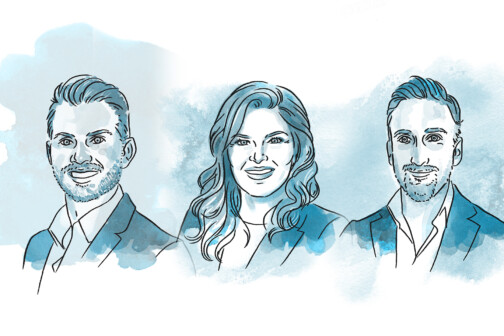His employees know he’s “kind of scattered,” but they roll with it. “They would prefer to have somebody more on top of things, but I think that’s where employees are supposed to pick up the shortfall,” he says.
MANAGING ADHD EMPLOYEES
For company leaders, managing employees with ADHD requires a philosophy that embraces the workers’ diverse needs and a willingness to harness their strengths in a way so they can be successful, says Jeff Kaye, co-CEO at Kaye/Bassman International Corp., an executive search and recruitment firm in Dallas.
“With an ADHD employee, ask what are the inherent competencies that are higher and how can I allow that condition to manifest itself in the most productive way,” he says.
An ADHD employee with unbridled energy and passion and an interest in working on many different projects could excel in a sales job if paired with another employee who is good at research and administrative work. Offering an accommodation rather than expecting the individual to do all of the paperwork and computer time will likely improve productivity and job satisfaction.
There’s a fine line between accommodating an employee, however, and letting him use the disorder as an excuse for not improving.

“Your responsibility as a leader is to help the person see that they have these issues, but show them they can still work on them,” Kaye says. Leaders can suggest techniques—such as turning off notifications or only checking e-mail at certain times of the day—that will help minimize distractions.
Kaye believes our multitasking culture is grooming new generations of workers who will continue to struggle with ADHD-type issues, so leaders need to be prepared to deal with it, whether employees are diagnosed or not.
“I do truly believe this is something that’s not going to get better in time; it will get worse,” he says. “There’s a percentage of the Gen Y-ers who will be higher [in this area]. We can’t argue that their brain chemistry has changed [significantly], so it must be environmental conditions. It’s like throwing kerosene on the match.”
TREATMENT OPTIONS
Adults are better than children at developing coping skills and organization and management skills to deal with ADHD, and some may not require medication for it. For the 85 to 90 percent of those who take medications for ADHD, they say it practically changes their lives. The remaining 10 to 15 percent find the medicines don’t work or they have too many side effects, such as difficult sleeping, decreased appetite, and decreased emotions.
Although it might seem counterintuitive to use stimulants to treat a hyperactive person, that’s exactly what their brains need to help control impulsive behavior or concentration.
“People with ADHD tend to have fewer neurotransmitter stimulators, so they’re under aroused and they can’t focus or get much done,” Roberts says. “The medication stimulates the neurotransmitters so they can do their jobs.”
Most of the Class C controlled substances —Ritalin, Metadate, Concerta, Daytrana, Adderall, Desoxyn, Dexedrine, and Dextrostat—used to treat ADHD haven’t changed much in the last few decades. But a handful of nonstimulates, including Stattera, are newer to the scene, as is the use of neurofeedback, where repetition trains the frontal lobe of the brain to produce the desired brain waves.
Treatment all depends on how significantly ADHD is affecting the adult. Licensed professional counselor Dulce Torres, who offers ADHD coaching and treats patients in her North Texas practice, says she evaluates the whole picture. Often there is a learning disability, such as dyslexia, or an anxiety disorder or depression linked to an individual with ADHD.
Through her practice and volunteer work with the North Texas CHADD group, Torres helps show people that ADHD is a real condition, but one, like diabetes, that can be managed. CHADD offers support groups and programs in Tarrant County, Grapevine/Southlake, and Dallas.
Business owner Lofgren stayed on Adderall for four years until he made some diet and exercise adjustments that he says transformed his life. Two years ago, he kicked his 14-Diet-Cokes-a-day-addiction, quit smoking, and eliminated dairy and gluten from his diet. His pants size has dropped from a 34 to a 29, he doesn’t need an alarm clock anymore, and he says he recently sat through a three-day executive seminar without any issues.
“I couldn’t have done that before,” Lofgren says. “Nobody is saying the doctors aren’t saving lives every day, but there are many things we wouldn’t have to turn to drugs for if we would just be responsible for how we feed ourselves.”
Although Adderall made him productive, he says a “clear mind” now has inspired him to creatively look for ways that he and his business can make a difference in the world.
Roberts, the psychologist, reiterates that ADHD is a brain disorder, but agrees that reducing or cutting out processed foods, junk food, too much sugar and red dye, and stepping up exercise can all help improve ADHD symptoms.
Kinsler of the Texas Rangers says he mainly uses medication to manage his ADHD, but believes that actively exercising all of his life has definitely helped.
Unfortunately, not everyone with ADHD gets to become a professional baseball player or enjoy long-term professional or personal relationships, Roberts says.
“There are so many adults who have been walking around with ADHD their whole lives,” he says. “They managed to get through with a lot of bumps and bruises along the way, but they really just underachieved relative to their ability levels. For a lot of adults, with treatment, life could be a whole lot easier.”
Other Resources
• North Texas Chapter of Children and Adults with Attention Deficit/Hyperactivity Disorder (CHADD), www.chadd.net
• ADD in the Workplace, by Kathleen Nadeau, Ph.D.
• Working in the Smart Zone, by Plano psychologist Susan Fletcher, Ph.D.
• Copy This!, by Paul Orfalea, founder of Kinko’s






